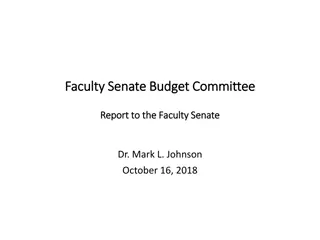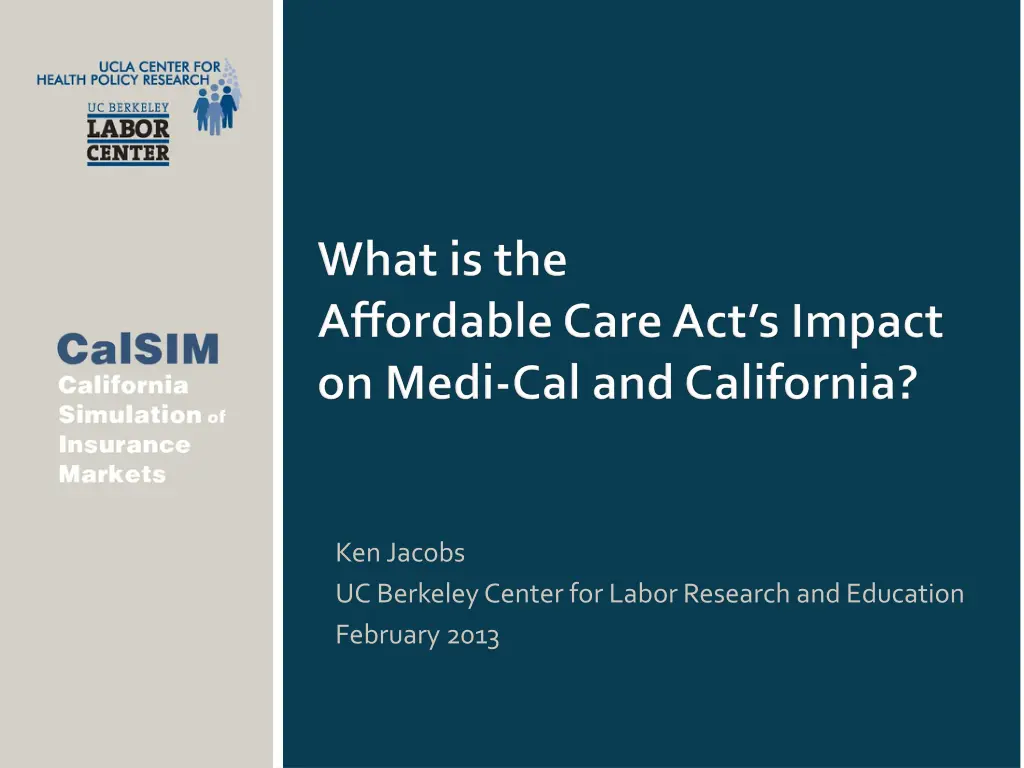
Eligibility for Medi-Cal Under ACA in California
Explore eligibility and enrollment estimates for Medi-Cal in California under the Affordable Care Act (ACA), including insights on income levels, demographics, and enrollment projections. Learn about the impact of the ACA on employer decisions to offer coverage and individual decisions to obtain coverage, as analyzed by UC Berkeley and UCLA. Discover the breakdown of eligible individuals by income, race/ethnicity, and source of insurance, providing valuable insights into healthcare access and coverage trends in California.
Download Presentation

Please find below an Image/Link to download the presentation.
The content on the website is provided AS IS for your information and personal use only. It may not be sold, licensed, or shared on other websites without obtaining consent from the author. If you encounter any issues during the download, it is possible that the publisher has removed the file from their server.
You are allowed to download the files provided on this website for personal or commercial use, subject to the condition that they are used lawfully. All files are the property of their respective owners.
The content on the website is provided AS IS for your information and personal use only. It may not be sold, licensed, or shared on other websites without obtaining consent from the author.
E N D
Presentation Transcript
Ken Jacobs UC Berkeley Center for Labor Research and Education February 2013
Developed by UC Berkeley Center for Labor Research and Education and UCLA Center for Health Policy Research with support from The California Endowment Enrollment estimates produced for Covered California Predicts the impact of the Affordable Care Act (ACA) on employer decisions to offer coverage and individual decisions to obtain coverage in California Uses public data sources mostly state-specific, including California Health Interview Survey
Adults under age 65 with income below 138% Federal Poverty Level (~$15,000 single individual, ~$32,000 for a family of four) More than 1.4 million eligible in 2014-2019 Roughly 75% adults without children living at home 750,000-910,000 expected to enroll by 2019
Newly Eligible for Medi-Cal by Source of Insurance without the ACA, 2019 Employer Sponsored Insurance 330,000 23% Uninsured 880,000 60% Individual Market 250,000 17% Total Eligible: 1,460,000 Source: UC Berkeley-UCLA CalSIM model, version 1.8
Californians under Age 65 Newly Eligible for Medi-Cal, Base Scenario, 2019 Race/Ethnicity English Proficiency Other 50,000 3% 18+ Limited English Proficiency 520,000 35% White 490,000 34% Latino 710,000 49% 18+ Speaks English Very Well 950,000 65% Asian 100,000 7% African American 110,000 7% Source: UC Berkeley-UCLA CalSIM model, version 1.8
Eligible for Medi-Cal but Not Enrolled by Source of Insurance without the ACA, 2019 Uninsured 880,000 35% Employer Sponsored Insurance 1,360,000 54% Individual Market 290,000 11% Total Eligible: 2,530,000 Source: UC Berkeley-UCLA CalSIM model, version 1.8
240,000-510,000 expected to enroll by 2019 71% of those eligible are children, remainder are parents Most of increase will happen regardless of the Expansion due to mandatory provisions of ACA: minimum coverage requirement for individuals; simplified eligibility, enrollment & renewal processes; and improved awareness of coverage.
Californians under Age 65 Predicted to Take Up in the Subsidized Exchange and Medi-Cal, 2014-2019 (in millions) Enhanced Enhanced 1.42 Enhanced 1.37 1.22 Base Base 0.99 Base 0.86 0.68 2014 2016 2019 Source: UC Berkeley-UCLA CalSIM model, version 1.8 8
100,000 new jobs per year in California due to ACA provisions including the Medi-Cal Expansion, according to Bay Area Council Economic Institute Research suggests that health insurance coverage can improve educational outcomes and worker productivity Sources: Haveman and Weinberg 2012; Levine and Schanzenbach 2009; Pitard, Hulsey, Laditka and Laditka 2009; Dizioli and Pinheiro 2012; Nguyen and Zawacki 2009.
Previous Medicaid expansions associated with reduced mortality Adults with Medicaid in Oregon were more likely to have regular place of care, usual doctor and use preventive care Sources: Sommers, Baicker and Epstein 2012; Baicker and Finkelstein 2011.
100% of health care costs for newly eligible in 2014 through 2016, phasing down to 90%in 2020 and future years; 50% for parents and children who are already eligible for Medi-Cal; 88% for Healthy Families children in 2015 to 2019, and 65% in 2014; and 50% of administrative costs for all Medi-Cal enrollees and 65% for those eligible under Healthy Families.
Share of New Medi-Cal Spending Federally-Paid with Expansion Source: Lucia L, Jacobs K, Watson G, Dietz M and Roby DH. Medi-Cal Expansion under the ACA: Significant Increase in Coverage with Minimal Cost to the State. January 2013.
New State General Fund Spending with Expansion ($ millions) Source: Lucia L, Jacobs K, Watson G, Dietz M and Roby DH. Medi-Cal Expansion under the ACA: Significant Increase in Coverage with Minimal Cost to the State. January 2013.
Source: Lucia L, Jacobs K, Watson G, Dietz M and Roby DH. Medi-Cal Expansion under the ACA: Significant Increase in Coverage with Minimal Cost to the State. January 2013.
Movement of some individuals from partial- to full-scope Medi-Cal with higher match rate State prison costs Higher reimbursement for hospital services outside of the correctional system Increased mental health and substance use coverage could reduce incarceration over time County savings harder to quantify
Uninsured Californians under age 65, 2019 4,010,000 930,000 23% 3,110,000 Other (has an affordable coverage offer from Exchange or Employer) 580,000 19% 1,180,000 29% Eligible for Medi-Cal 790,000 25% 830,000 21% 710,000 No offer of affordable coverage (>8% income) 23% Not eligible due to immigration status 1,070,000 1,030,000 27% 33% Base Enhanced Source: UC Berkeley-UCLA CalSIM model, v1.8
UC Berkeley Center for Labor Research and Education: http://laborcenter.berkeley.edu/healthcare/ Ken Jacobs (kjacobs9@berkeley.edu) UCLA Center for Health Policy Research http://healthpolicy.ucla.edu/Pages/home.aspx Jerry Kominski (kominski@ucla.edu) Dylan Roby (droby@ucla.edu)






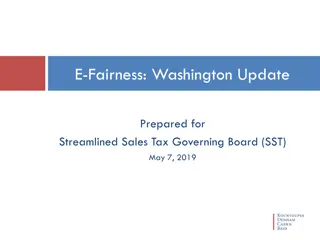



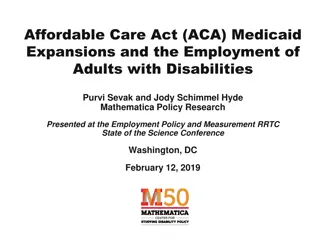
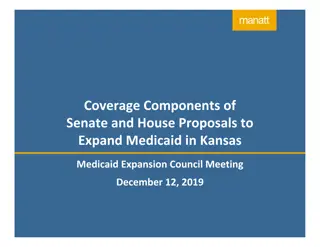



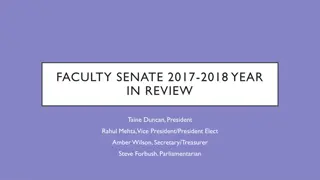

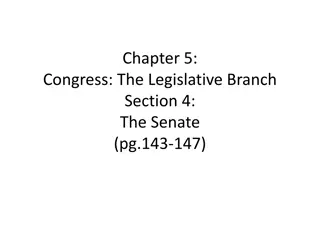



![Overview of the Faculty Senate at [Institution Name]](/thumb/233771/overview-of-the-faculty-senate-at-institution-name.jpg)
